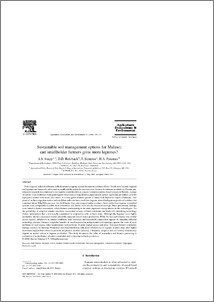Sustainable soil management options for Malawi: can smallholder farmers grow more legumes?
Abstract
Sole-cropped, unfertilized maize is the dominant cropping system throughout southern Africa. Yields have become stagnant and legumes are frequently advocated as an affordable option for resource poor farmers, to enhance productivity. Farmer participatory research was employed to test legume intensification as a means to improve maize-based systems in Malawi. A range of options were evaluated, from grain/legume intercrops of long-duration pigeonpea (Cajanus cajan) and groundnut (Arachis hypogaea) rotated with maize (Zea mays), to a relay green manure system of maize with Tephrosia vogelii. Two years of on-farm experimentation indicated that under on-farm conditions legume-intensified systems produced residues that contained ~50 kg N/ha per year, two-fold higher than sole-cropped maize residues. Grain yields from legume-intensified systems were comparable to yields from continuous sole maize, even in a dry lakeshore ecology. These preliminary findings were linked to farmer assessment, where farmers participating in the trials expressed strong interest in the technologies. Yet the probability of adoption remains uncertain. Associated surveys outlined constraints and trade-offs underlying technology choice, information that is not usually considered in conjunction with on-farm trials. Although the legumes were highly productive, farmers expressed worries about the marginal loss of maize production. While the trial performance was similar across regions, differences in market condition, farm resources and household composition appears to stimulate different technology choices. Farmers weigh the benefits of weed suppression and potential cash earnings, against the costs of seed, problems of seed access, labour requirements and problems of grain market access and price. Surveyed farmers commonly manage residues by burning. Promotion and experimentation with more efficient use of legume residues may offer higher short-term impacts than efforts to promote adoption of another cash crop. Ultimately, adoption and soil fertility benefits may depend on market returns to legume production. This study documents the value of researchers and farmers partnering in evaluation of technologies, adoption constraints and competing technology choices

